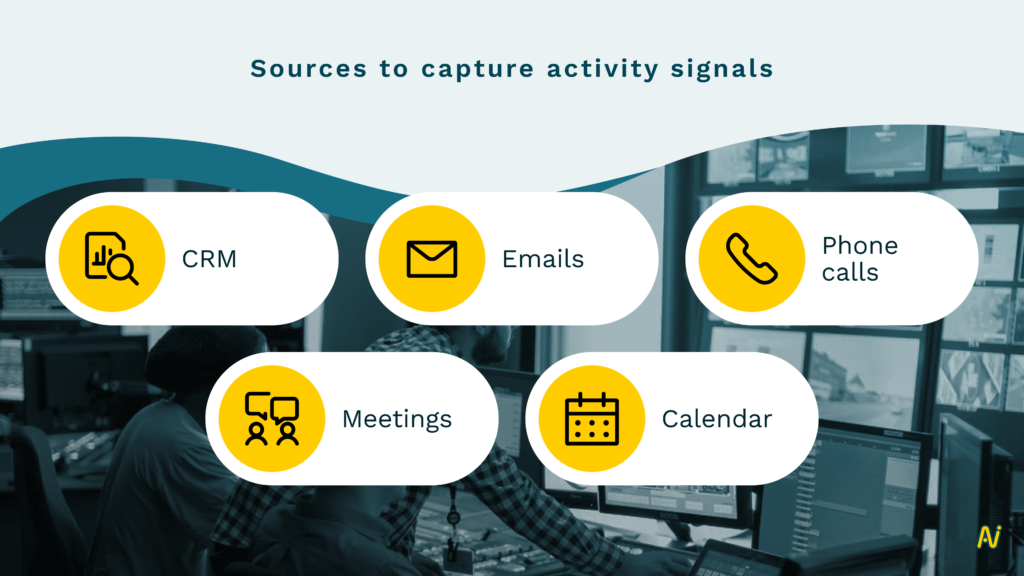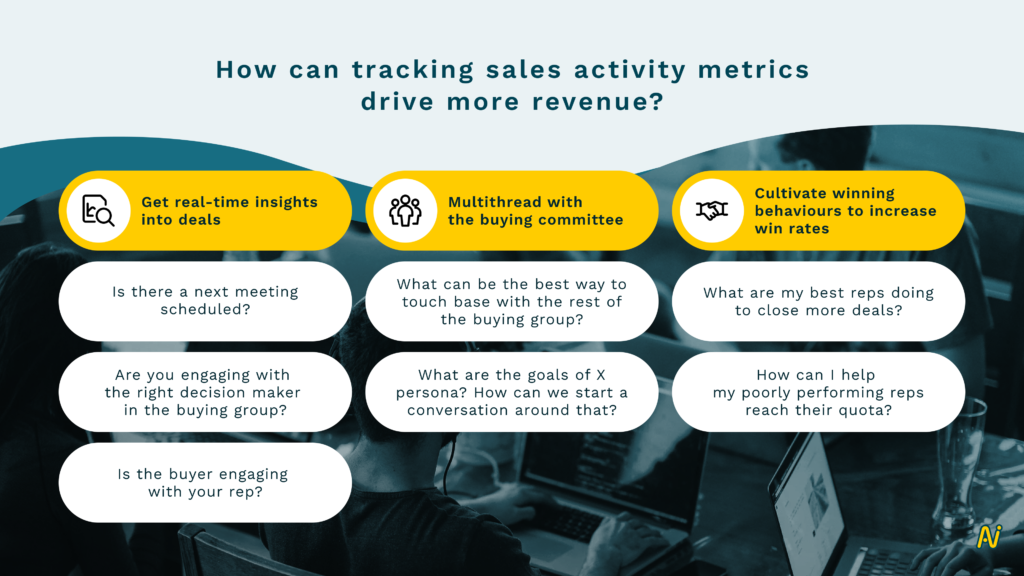Driving revenue is no longer a solo effort. It is a relay. Sales, marketing and customer success teams work together to reach a common goal – higher revenue.
And it’s not about revenue generation alone. It’s about how revenue teams can drive predictable revenue quarter after quarter.
This revenue engine can run when all revenue-generating functions work like a machine. Every part of this GTM machine should run on time and in a smooth manner to propel deals forward.
To run this predictable revenue machine, you need to know what’s happening in your business. What opportunities are currently stalled and why? Which reps aren’t hitting their quota? Which reps do not have enough pipeline coverage against quota?
Visibility alone isn’t enough. The ability to integrate those insights into your candences in critical. In short, everyone in your revenue generating teams know what they need to do to hit revenue targets.
You can find answers to such critical questions with a sales activity data. Insights from sales activity data help revenue leaders identify risks well ahead in time. They can take the necessary action to prevent those risks. This ensures the revenue engine keeps running without any blockages.

What is Sales Activity Data?
Sales activity data tracks every activity that your sales teams undertake with accounts. It covers every action that your sales teams make to close a deal.
Sales activity data also captures the return interaction coming from your accounts. For example, if your sales rep sends an email to a prospect, it is an activity data that will get tracked. If the prospect responds, that will get tracked too.
Activity signals can get captured from sources like:
- CRM
- Phone calls
- Meetings
- Calendar

Here’s an example.
A prospect comes through your website and downloads a PDF. A sales rep employs a sales engagement tool to reach out to the prospect. A meeting gets booked. The first call goes great, and the rep has his hopes high up in the clouds.
The sales rep predicts that this deal will close in the next 60 days. But is that the case?
Sales forecasting requires more data than instincts. You need answers to questions like:
- Is the prospect a key decision maker?
- Are there enough follow-up meetings booked?
- Is the prospect engaging with the sales rep?
All this data is important to forecast whether a deal will close in the future or not. You need to understand your team’s activity data to get the full story. Otherwise, your team might spend time on a deal that isn’t even real.
The Link Between Sales Activity Data & Sales Productivity
Selling is getting complex. 93% of sales reps are finding virtual selling complex. 75.7% of sales reps missed their quotas last year.
Poor sales productivity has a direct impact on revenue. Revenue leaders are working hard to improve the productivity of their sales teams.

To navigate this complex environment, revenue leaders must use insights from the right data to inform their decisions. They use technology that captures and compiles sales activity data from various sources. This can be through emails, phone calls, meetings, social media, or other points of contact.
This data is accurate and comes from their own first-party sources. This data is accurate and free from bias. Gaining insights from data is a powerful way to increase productivity of sales teams. It gives leaders a clear view of the performance of their sales teams.
Revenue leaders get a clear idea of which activities lead to revenue and which do not. You can spot the strengths and weaknesses of your reps and sales team. The activity data shows you:
- What have your top and bottom performing reps done to close sales?
- What makes your best reps stand out?
With this data, you can see which activities correlate to future success. You don’t have to apply generic principles or rely on your instinct to make reps more productive. Instead, sales activity metrics will tell you what works for your current sales team.
In short, with insights from your activity data, you can make your sales teams more productive.
What Makes Sales Activity Data So Valuable?
As a revenue leader, you already have a good sense of which activities lead to more revenues. For example, you know prospecting will generate more revenue than spreadsheet data entry.
But do you know the exact connection between sales activities and revenue generation? For example,
- How many follow-ups does it take for a prospect to respond?
- What is the correlation between the number of demos given and deals closed?
- How many qualified leads do you need each quarter to hit quota?
These numbers will vary by organization, product, industry, sales team and sales rep. The equation will be different for every company. But these numbers are important to know to remove any kind of friction from the sales process.
Sales activity data is very useful because it provides leading indicators. Leading indicators are metrics that act as predictive measures of future performance. These are early activities that translate into pipeline generation and conversion.
Leading indicators can inform your sales managers about activities that help close deals. AI can translate these activities into behavioral data insights. These insights tell sales managers about what needs to be done to change behaviour of reps. Access to activity data insights turns coaching sessions into proactive discussions.
Your sales reps need to engage in activities that generate revenue. The more they do the right tasks, the higher will their win rate be. And the more of “wrong” things they repeat, revenue will continue to slip through the cracks.
How Can You Capture Sales Activity Data?
Sales activity data can be captured revenue intelligence platforms. These platforms use AI to generate actionable insights from sales activity data. Such insights can be used to close more deals and build a high-performing sales team.
Activity data capture the behaviour of your sales reps. They can include details such as:
- How many meetings has your sales reps booked for the week?
- How many emails does your rep send in a day?
- How many calls does your rep make in a day?
Revenue intelligence platforms collect all this data from various sources. It then brings this activity data under one roof. Your sales, marketing and customer success teams can have access to this unified data. This helps your GTM execution stay on track.
How Can Tracking Sales Activity Data Drive Revenue?
With insights from sales activity data, you can uncover blindspots in your revenue engine.
Here are some key advantages:
1. Get real-time insights into deals
Imagine a large deal where there has not been any conversation happening for over a month. The questions to ask to move this deal forward could be:
- Is there a next meeting scheduled?
- Are you engaging with the right decision maker in the buying group?
- Is the buyer engaging with your rep?
With such details, you can identify processes and engagement gaps at a deal and a rep level.
Sales activity data gives you a granular view of all deals in your pipeline. You can see which deals are moving forward and which deals are at risk of getting stalled.
2. Multithread with the buying committee
Imagine your rep has a strong relationship with the champion of an account. But the engagement with the rest of the stakeholders in the buying group is low.
This could be a risk. But when you have this data, you can immediately figure out:
- What can be the best way to touch base with the rest of the buying group?
- What are the goals of X persona and how can we start a conversation with them around that?
Insights from sales activity data gives a clear view on your buying committee. You can know if your reps are engaging with the right stakeholder across the buying group. When the right stakeholder engaged early enough, you can prevent deals from slipping.
This will allow your reps to establish strong relationships with all key stakeholders. And sellers who multithread see a 34% lift in win rate and a 10% decline in total deal length cycle.
3. Cultivate winning behaviours to increase win rates
You already know who are your A-players. But do you know what makes them crush their quota every quarter? What are the habits they indulge in? What activities do they undertake to close deals?
Insights from sales activity data gives you an entire picture of behaviours that help win deals. You can see what works and what doesn’t. You can share these insights with your entire sales team.
You can find answers to questions like:
- What are my best reps doing to close more deals?
- How can I help my poorly performing reps reach their quota?
Let’s assume your most successful reps make 50 calls a week, and your least productive reps only make 20. Now that you have this activity data, you can devise a strategy to make the latter increase their calls.

Align Behaviour to Strategy With Effective Coaching
Effective sales coaching can be a game-changer for organizations. By knowing the areas where reps are lacking, sales managers can know which areas to coach them on. This reduces time wastage and leads to action that pushes deals forward.
An overwhelming 93% of sales reps are experiencing significant challenges with virtual selling, but in spite of coaching, most of those sales reps are unsure what they should be doing differently to execute their jobs effectively in this environment. Sales managers are the lynch pin to this challenge. The success of a virtual selling engine depends on the managers ability to coach to the right skills and in the right way.
Danielle McKinley, Director of Research and Advisory, Gartner
With sales activity data, your sales managers can define the areas to coach their reps on. For example, lack of following up continues to be one of the top reasons for losing out on deals. 44% of salespeople give up after one interaction with a prospect. If a sales manager has a follow-up score of a rep for a key account, they can nudge the rep immediately to follow-up.
As more activity data gets available, and technology gets more advanced, revenue leaders can expect better coordination among sales managers and reps to drive predictable quarters. With the right insights, organizations can help reps focus on what matters most. This will help reps use their time well. One-on-one conversations between managers and reps can have a direct impact on revenues.
Generate contextual insights from your sales activity data to measure if your sales team is following the right behaviours to hit their targets. With a clear idea of correlations between specific activities and outcomes, your managers can offer personalized coaching to individual reps. And eventually drive more revenue.








